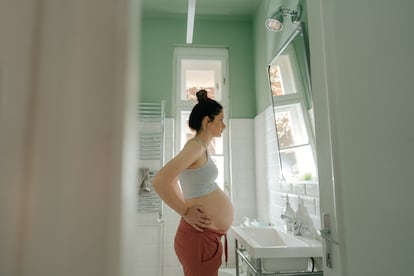Why does a woman’s nose change shape during pregnancy?
Hormone-induced fluid retention and vasodilation cause this part of the face to widen and redden during gestation

For weeks, pregnant women have been uploading videos on social media websites like TikTok to show how their noses have changed during pregnancy. One can see a widening and reddening of the nose in the before and after images they post. But how do experts explain this physical metamorphosis? “Changes in the nose happen because of the fluid retention and dilation of the blood capillaries that occur during pregnancy to prepare the body for childbirth,” explained Patricia Barbero, an obstetrician and the coordinator of the Childbirth Care Unit at Madrid’s 12 de Octubre Hospital. Whether these changes are visible or not, she said, they generally occur in most pregnant women as a result of the edemas produced by an increase in blood volume, which serve to compensate for the blood loss during childbirth (between 500 milliliters and one liter).
In some cases, fluid retention and edema leading to changes in a pregnant woman’s face may stem from other causes: “It can be [from] increased blood pressure at the end of pregnancy, which can be aggravated by preeclampsia—high blood pressure and signs of liver or kidney damage that occur in women after the 20th week of pregnancy—or changes in blood pressure.”
According to Raimundo Gutiérrez, the head of the Otorhinolaryngology [Ear, Nose and Throat] Department at Madrid’s Rey Juan Carlos University Hospital, the nose widens because of a change in the structure of the nose’s soft areas. “There is fluid retention in the face that causes the tissues to thicken. Hormone-induced vasodilatation, which sometimes causes facial and nasal reddening, causes the nose to become wider in the subcutaneous region,” he explained.
@kimberr98 not my finest hour or 9 months 😅 inspo from @tabsalterego #greenscreen #pregnancy #pregnancynose
♬ Devil Eyes - There I Ruined It
Gutiérrez explained that other changes also occur in the nose during pregnancy, such as congestion of the nasal turbinates and mucosa, which leads to increased mucus production, itching, sneezing and difficulty breathing through the nose: “This is called pregnancy rhinitis.” He said that women often self-medicate to alleviate these symptoms with products such as vasoconstrictor sprays, which may seem to improve them. However, he warned that the relief “is only temporary, because a so-called rebound effect occurs, which worsens [the situation] and can even cause perforations in the nasal septum; in the most severe cases, it requires surgery.” This medication also poses other risks: “[It] can be absorbed and cause a change in uterine dynamics, which, in advanced stages of pregnancy, can sometimes induce premature labor.”
@clonvelin Pregnancy nose syndrome is real 😭 #pregnant #pregnancy #momsoftiktok #fyp #fypシ #foryoupage #pregnanttiktok #pregnantbelly #pregnancyjourney #beforeandafter #viral #stayathome #sahm #stayathomemom
♬ Devil Eyes - There I Ruined It
The sense of smell and the survival instinct
The sense of smell is often associated with instinct. Common phrases like “this smells off to me” allude to that connection. Some cultures, such as the Inuit (commonly known as Eskimos), the indigenous peoples living in the Arctic territories of America, Greenland and Siberia, sniff each other as a greeting, which also serves to gather information about the other person. In pregnant women, the sense of smell is often heightened. “But there is a controversy over this, because no significant differences [in the sense of smell] have been found between pregnant women and non-pregnant women. That is probably because of hormonal changes and not the size of the nose,” said Dr. Patricia Barbero.
The obstetrician explained one of the hypotheses about pregnant women’s sharpened sense of smell: “Smell is the main mechanism we humans have for detecting toxic substances, such as chemicals or spoiled food… In the first trimester of pregnancy, especially, women have a more acute sense of smell and feel aversion to certain odors to protect the fetus during the period [when there’s the] greatest danger for defects to develop.”
@kellieamartinez #stitch with @heyosato #greenscreen #pregnancy #beforeandafter #pregnancynose #whoisthat #lol #swollennose #pregnantnose #pregnantnoseisreal #bignose #beforeandafternose #lmao #whoisshe #help it looks more normal now but like 😶
♬ original sound - Kellie Brennan
In short, as Barbero explained, pregnant women’s state of sensory hypervigilance stems from the hormonal changes that occur during gestation and the postpartum period (the months after childbirth). All of these changes promote the bond between a mother and her newborn and help ensure the baby’s survival: “The sensory organs are exceptionally active; it’s not only smell, but also hearing to capture the baby’s cry and touch, which is why skin-to-skin contact is so important in activating this hormonal and emotional cascade and in developing a healthy emotional bond between the mother and her child.”
Sign up for our weekly newsletter to get more English-language news coverage from EL PAÍS USA Edition
Tu suscripción se está usando en otro dispositivo
¿Quieres añadir otro usuario a tu suscripción?
Si continúas leyendo en este dispositivo, no se podrá leer en el otro.
FlechaTu suscripción se está usando en otro dispositivo y solo puedes acceder a EL PAÍS desde un dispositivo a la vez.
Si quieres compartir tu cuenta, cambia tu suscripción a la modalidad Premium, así podrás añadir otro usuario. Cada uno accederá con su propia cuenta de email, lo que os permitirá personalizar vuestra experiencia en EL PAÍS.
¿Tienes una suscripción de empresa? Accede aquí para contratar más cuentas.
En el caso de no saber quién está usando tu cuenta, te recomendamos cambiar tu contraseña aquí.
Si decides continuar compartiendo tu cuenta, este mensaje se mostrará en tu dispositivo y en el de la otra persona que está usando tu cuenta de forma indefinida, afectando a tu experiencia de lectura. Puedes consultar aquí los términos y condiciones de la suscripción digital.










































